NEWCASTLE, Northern Ireland — The cool mist coats you in a thin, salty sheen, like a cloud layer coming to life all around you. The breeze off Dundrum Bay whips your woolen hat and the corners of your coat, an elemental force following you like the ghosts of the game’s legends and lore.
Here, in this quaint corner of a big, emerald isle, on the grounds of the world’s top-ranked course, a grand old girl named Royal County Down, golf’s ghosts aren’t simply superstition. They’re every bit as true and tangible as the turf you trod upon, this hilly land sprawling out to sea, just below the misty Mountains of Mourne.
We’ve come to these shores to see if golf in Ireland could truly live up to the legend, one filled with endless emerald fairways and craggy cliffs, of frothy pints in low, loud little pubs, of warm welcomes wherever adventure takes us.
What we found was that the legends weren’t only true — they’re even better than imagined.
We were far from alone in our pilgrimage here. The island has been inhabited since at least 10,500 B.C., after a narrow land bridge opened in the Irish Sea between the island and Britain, making it one of the world’s oldest tourist destinations. As the millennia passed, the land returned to sea, and the people of Ireland built roads, bridges, castles and cities. Somewhere around 140 A.D., the village that would one day be known as Dublin was formed, called Eblana, a humble start to what would one day be one of Europe’s most influential cultural hubs.
Fast-forward to a few hundred years ago or so, when some shepherds across the pond started hitting rocks with their crooks, unwittingly inventing the game of “golf.” The game would be banned by King James II in 1457, only later to revive and thrive across the country, and eventually, elsewhere. Everywhere.
Golf didn’t find its way to these shores in earnest until the 19th century, when Royal Curragh Golf Club became the first course on the island in 1852. In the nearly 270 years that followed, golf in the country has become nearly as ingrained in the culture here as it has for the cousins across the Irish Sea. Indeed, it’s safe to say if Scotland is the home of golf, Ireland is its seaside summer cottage, a fantastical place full of world-renowned courses in seemingly every corner. Tralee. Lahinch. Ballybunion. Old Head. The list goes on and on, an endless array of lush green fairways, folding over every rocky hill and dale across the island. All told there are nearly 400 courses dotting the 32,595 square miles of rugged Irish landscape — comparatively about the size of Indiana, were it surrounded by icy water and emerald-crowned, craggy cliffs.
We’d come to play the best this island — or anywhere, for that matter — has to offer, including a most triumphant trio: a seaside course started by the Jameson Irish Whiskey family, the 2019 British Open course, and the most revered course on the planet — the regal Royal County Down.
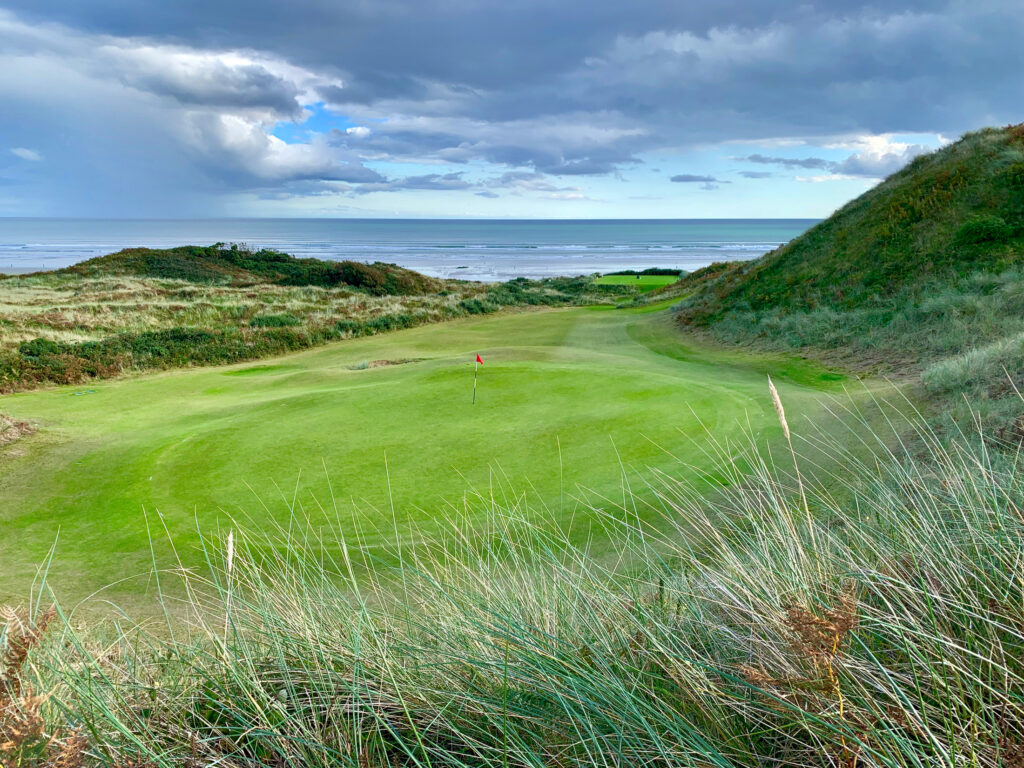
The spectacular seaside second hole at Royal County Down is one of a thousand photo opportunities.
BEAUTY BY THE BAY
Located just a stone’s throw from Dublin Airport, on a sandy sliver of land called Portmarnock Beach, is the lavish Portmarnock Hotel & Golf Links, a bit of modern convenience and luxury surrounded by old-world charm and rich history.
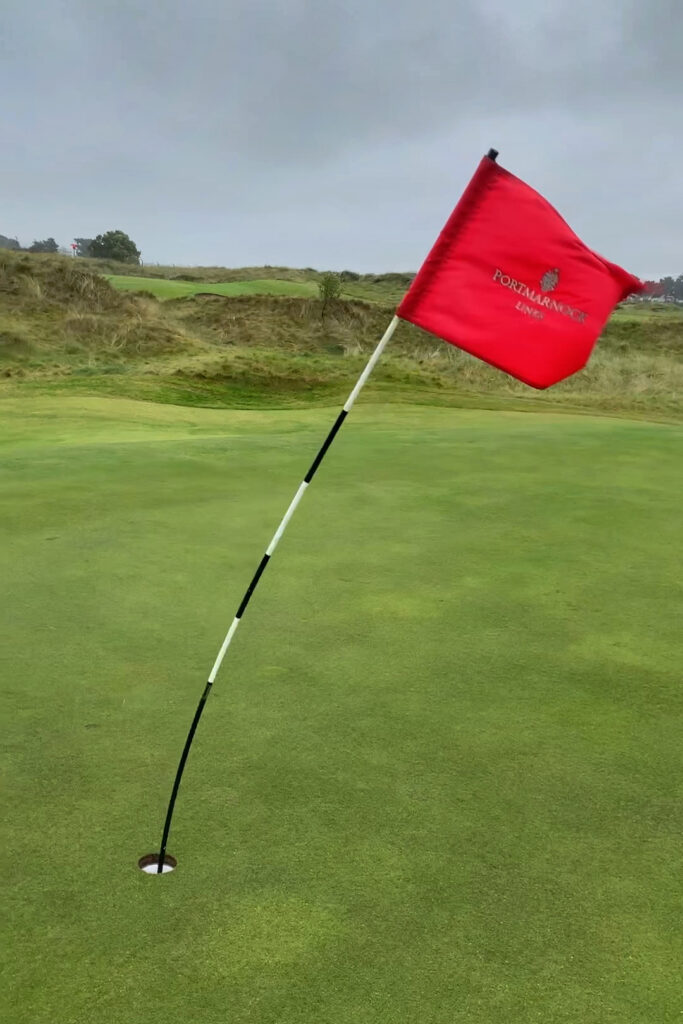
Ireland’s infamous weather can whip you into a frenzy.
The hotel itself was started in the 1850s by none other than the John Jameson family, of Jameson Irish Whiskey fame. The legendary founder’s grandson, John Jameson III, moved to St. Marnock in 1847, where he and his wife Anne had five children. His eldest, John Jameson IV, inherited the estate in 1881, and rebuilt it into a 10-room hotel, before it eventually became property of his uncle, Willie Jameson, a wealthy Dublin socialite and a close friend of British royals.
Today the Jameson family is no longer directly involved, but their influence is found throughout the opulent resort, much like it is everywhere else in Ireland.
Steeped in history, the hotel is a contemporary beauty today, an award-winning, five-diamond affair filled floor-to-ceiling with white marble and glass.
We arrived on a quintessentially Irish fall day, with dense clouds rolling in off the sea and bringing the promise of rain and wind along with them. We were undeterred.
With fine dining in The 1780 or simpler fare in the Jameson Bar or An Sibin Pub, a world-class spa and fitness facility, there’s plenty of things to keep you occupied indoors in inclement weather, if you’re so inclined. But weather wasn’t about to put a damper on our plans, not with the 7,100 yards of beautiful Bernhard Langer-designed golf course awaiting us out back.
The two-time Masters champion and Ryder Cup captain designed The Links Portmarnock in 1995, and since then has become a staple in Ireland’s championship circuit. Hosting the Ladies Irish Open, Irish Open qualifiers and numerous amateur, PGA and Ladies European Tour events.
While it might lack the pedigree of its famous neighbor, Portmarnock Golf Club, Langer’s Links course is special in its own right.
In a nod to its history, Langer incorporated the resort’s original nine-hole course built by the Jamesons into the design, and the first hole runs alongside the cemetery where members of the famous family came to final rest.
On this early October day, we teed off in the most miserable of conditions; stinging rain, 50 degrees and with 40-mile-an-hour gusts. Undeterred, we headed to the first tee, as the grounds crew shook their heads at us on their way to shelter. That opening hole, a generous, 374-yard par 4, is best known for the graveyard to the right, where many a player’s ball finds a home, right alongside the Jameson family plot.
Langer’s Links plays out like a highlight reel of classic Irish golf — pot bunkers, riveted bunkers, firm fairways, impenetrable fescue — with absolutely stunning dunesland and seaside views, to boot.
On a more favorable day, we would’ve found the course far more forgiving (we each hit driver into the wind on the 211-yard, par-3 17th, and only one of us reached the green), but Portmarnock Links was unforgettably fun nonetheless. And being just 15 minutes from Dublin Airport, it’s the perfect bookend to any golf pilgrimage here.
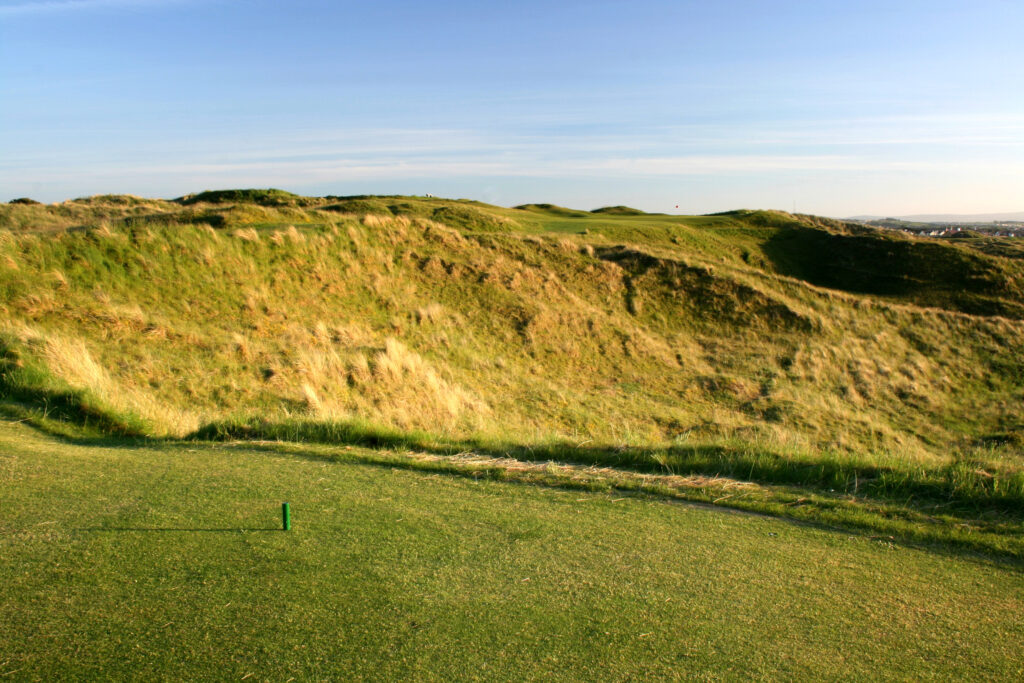
The stunning new par-3 16th at the Dunluce Links — “Calamity Corner” — requires a knee-knocking tee shot over the chasm.
WHAT A ‘RUSH’
Further up the Irish coastline, three hours outside of Dublin and through the towns of Drogheda and Dundalk, past the smokestacks of Belfast and Ballymena, and into the province of Northern Ireland on the shores of the North Atlantic, lies the charming resort town of Portrush.
Down by the seaside, just outside the city’s cobblestone streets full of shops, eateries and amusement park attractions, lies the area’s biggest attraction: Royal Portrush Golf Club. With its Valley and Dunluce Links courses, both designed by Harry S. Colt at the turn of the 20th century, Royal Portrush has become an international draw. Its Dunluce Links course has played host to a long line of championships, from the Irish Open to The Open itself — the first course outside Britain’s mainland to do so, in 1951 — as well as the British Amateur, the Senior British Open, and many others, more than 50 in all. The course is just as relevant today, too, having hosted the 2019 Open, won by Emerald Islander Shane Lowry, over Brit Tommy Fleetwood.
It’s played host to Portrush’s favorite son and Major champ, Graeme McDowell, and is the home club of Darren Clarke, too. Northern Ireland’s own Rory McIlroy owns the course record on the Dunluce Links, shooting a sterling 61 at the age of 16!
Yet it doesn’t take a golf historian to understand the irresistible draw to Portrush as a championship venue, it only takes two eyes. With soaring cliffs and crashing waves, rolling hills and towering tee shots found throughout, Portrush’s Dunluce Links is spectacular in every way.
That’s not to say it couldn’t be improved upon, of course, and so the course underwent a major renovation en route to the latest Open, hiring architect Martin Ebert to handle the honors. Among the many changes were the complete removal of the original (and comparatively weaker) 17th and 18th holes, making way for the Open’s vendor village. Instead, Ebert pilfered some unused acreage from the Valley course to create the new, 592-yard, par-5 serpentine seventh and incredible, 434-yard, par-4 eighth hole, featuring a dramatic drop and forced carry over a chasm.
The club also added tees to nine holes, stretching the course out to a stern, 7,317 yards, added 10 new bunkers and built five new greens. They even added a 65-yard hidden tunnel under the dunes for the Open players, between the 10th green and 11th tee.
The changes took 18 months to make, but the clear consensus was they were worth the wait; Royal Portrush was roundly celebrated for a successful tournament, nearly 70 years after its last Open. And while Shane Lowry will replay the highlight reel from his win for years to come, the course is a highlight reel all its own, starting with the uphill, 416-yard, par-4 first hole.
At the fantastic fifth, a 382-yard par 4 that finishes at the shore, you’ll get a glimpse of the links’ namesake: the dramatic ruins of the medieval Dunluce Castle, teetering on the edge of a basalt outcropping overlooking the crashing sea below, between Portrush and the town of Portballintrae.
The 189-yard, par-3 sixth hole is equally stunning, with a panoramic view of the North Atlantic filling your field of vision, and the perfect setup to the stellar new seventh and eighth holes.
The back nine is every bit as dramatic, particularly in the famous (now) 16th, dubbed “Calamity Corner.” This 236-yard, par-3 knee-knocker forces you play over a chasm to a postcard green perched on a steep hillside. The 405-yard 17th (“Purgatory”) awaits next, with a needle-nosed fairway leading to a drivable green from its towering tee. Lastly, the revamped finishing hole — formerly the 16th — is the 473-yard, diabolical dogleg of a par 4 called Babington’s, after Sir Anthony Brutus Babington, who was instrumental in the course’s creation.
Afterward, as you toast your triumphant rounds in the Babington Room overlooking the course, you’ll intimately understand the irresistible draw to Royal Portrush and the Dunluce Links. It’s a course named for a castle, and fit for a king.
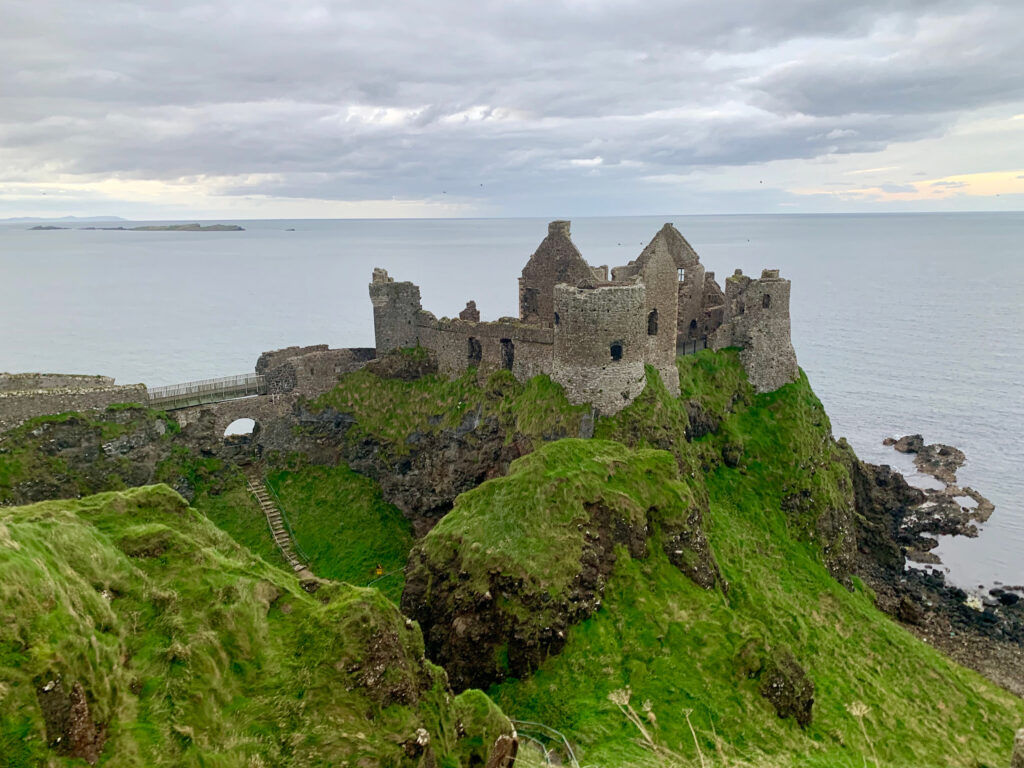
Dunluce Castle nearby is an attraction all its own, and visible from the course.
‘ROYAL’ & ANCIENT
Two hours southeast, back through the midweek bustle of Belfast, is the quaint town of Newcastle, in the country’s County Down. The county was named one of the best places to live in the entire United Kingdom, and it’s little wonder why: County Down is a mythical kingdom all its own, with gleaming cities, majestic mountains and serene seaside towns.
Tucked behind the Mountains of Mourne on the shores of Dundrum Bay might be County Down’s greatest amenity: Royal County Down Golf Club. Built in 1889 within what is now the Murlough Nature Reserve, RCD is ranked the No. 1 golf course in the world, for all the reasons you can see and for many you can only feel by playing it.
The club’s original nine holes were designed by a Scottish schoolteacher named George L. Baillie. Almost immediately after it opened in spring of 1889, its wealthy Belfast investors hired a man named (Old) Tom Morris to visit from St Andrews to tweak the design and complete the loop. Old Tom was to be paid “a sum not to exceed £4.”
It was money well spent. Old Tom routed the new layout through the hills and dales spilling out to sea from the mountains, and Royal County Down officially became an 18-hole championship course in July of 1890. It’s undergone some noticeable nips and tucks since then, notably the new fourth and ninth holes, courtesy of Harry Colt in 1925, and most recently a new 16th hole in 2004.
Naturally, Royal County Down has been home to a long line of amateur and professional championships through the years, from the Irish Amateur, to the Walker Cup and Senior British Open. It’s also a must-play for many of the game’s greats when the opportunity arises, often making for a tough, fitting tune-up for The Open.
For most lucky enough to come here, however, Royal County Down remains the main event. Staying at the lavish Slieve Donard Resort & Spa adjacent to the club, you can’t help but feel the electric anticipation on the two-minute walk down the path to the course.
For being the named the finest course in the world, you’d never know it by Royal County Down’s understated clubhouse, pro shop and simple, unattended starter shack next to the first tee. It’s an unpretentious place, which only lures you into a false sense of security as you prepare to take on the many traps and tricks it has in store for you.
We wisely hired a forecaddie to serve as our guide around the countless hidden hills, humps and blind shots Royal County Down keeps as its secrets — and to hopefully help us out of trouble amid the thick heather and golden gorse awaiting every miscue along the way. The course serves up nearly a dozen blind shots throughout your round, with only black-and-white striped barber poles and white-painted rocks in an attempt to guide your way. But to virgin eyes, Royal County Down can give you the impression you’ve wandered away from the course confines and are suddenly trapped in Ireland’s rugged, untamed terrain.
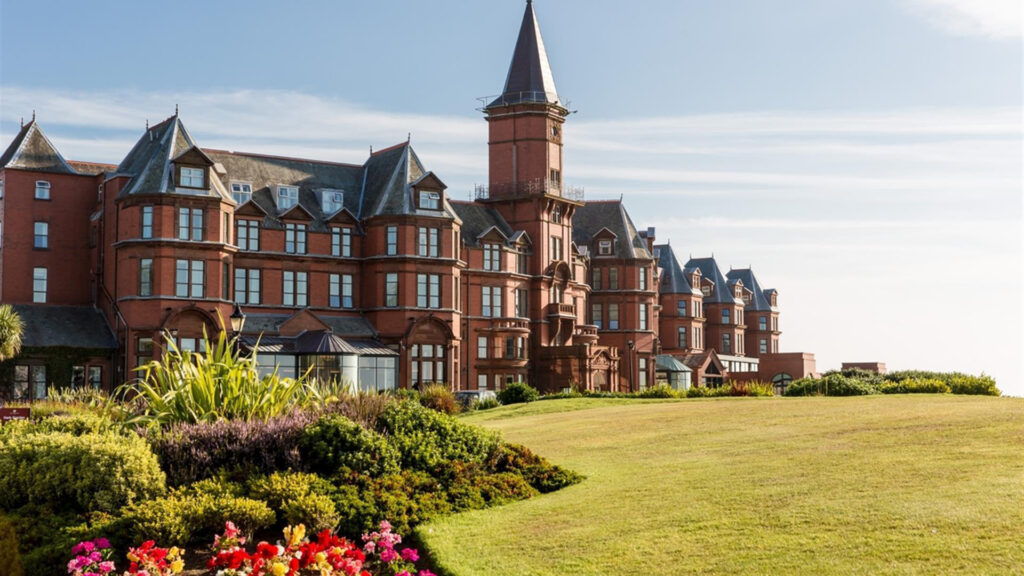
The Slieve Donard Resort & Spa
All in all, Royal County Down might just be the most uncanny, quirkiest course on the planet, but it only adds to the mystery and charm of the world’s top-ranked track. And from the very first hole, a sprawling, 539-yard par 5 skirting the shoreline just over the dunes to the right side, we knew we were in for something special.
Indeed, Royal County Down’s fabulous front nine has been called the best in all of golf, with good reason.
After heading out along the shoreline from behind the dunes at the first and second holes, we get our best view of the bay from the elevated tee of the monstrous, 475-yard, par-4 third hole. You’ll get another breathtaking view of the bay and the misty mountains beyond from the tee of the terrifying, 229-yard, par-3 fourth hole. The green slopes back to front and off the sides, right into a series of its gnarly pot bunkers.
A little white rock atop a nondescript mound guides the way home at both the 440-yard fifth and 396-yard sixth holes, blind shots even NORAD might have a hard time navigating.
The fabulous front nine concludes with a pair of long par 4s at seven and eight, before bringing you to the tee of the sensational signature hole, the 483-yard, par-4 ninth. It’s one of the most photographed holes in all of golf, for good reason, with the Mountains of Mourne, Dundrum Bay and even the stately spire atop Slieve Donard Hotel filling your field of vision. It’s enough to distract you from the challenge of the hole itself, with — you guessed it — another blind tee shot up and over a massive dune in the middle of the fairway.
Royal County Down’s back nine is highlighted by the “Irish Amen Corner” of the fantastic, 446-yard 13th, the tricky 212-yard 14th, and the serpentine, 468-yard, par-4 15th. Survive that gauntlet (reasonably) unscathed, and you’re in great shape for the finishing stretch, culminating with the spectacular, 548-yard, par-5 finale. With just two par fives on property, providing the bookends to an undoubtedly unforgettable round, the awesome 18th is pockmarked with more than a dozen bunkers on either side of the hole, guarding the severely sloped green — and glory.
The debate rages on in golf circles on which is the better of Northern Ireland’s twin titans, Royal Portrush or Royal County Down. In reality, they are as distinctly different as you’ll find in two links courses — one a dramatic, straightforward test of golf, and the other a beautiful, unfolding mystery.
Ultimately, it’s up to personal preference to decide, as either could easily lay claim to the crown. But like the bewitching dunesland of Royal County Down itself, some mysteries are their own reward.
For more information, visit www.ireland.com.
Take the Trouble Out of Your Trip
For hassle-free travel to the Emerald Isle, we arranged our trip through the U.K.’s premier golf travel experts at The Experience St Andrews. In addition to Scotland’s premier properties including the Old Course itself, The Experience St Andrews offers end-to-end service to Ireland’s greatest golf courses, including accommodations and dedicated travel service. Visit www.theexperiencestandrews.com.
Land of ‘Giants’
www.nationaltrust.org.uk/giants-causeway
Long, long before golf overtook Ireland’s rugged terrain — only 50 or 60 million years ago — a volcanic uprising underneath what is now Northern Ireland formed and forced nearly 40,000 basalt columns skyward, creating the three-mile-long stretch of towering rock called the Giant’s Causeway. Once believed to be built by giants to cross the sea, it’s now a must-see stop for nearly a million visitors annually, as the island’s only UNESCO World Heritage site.
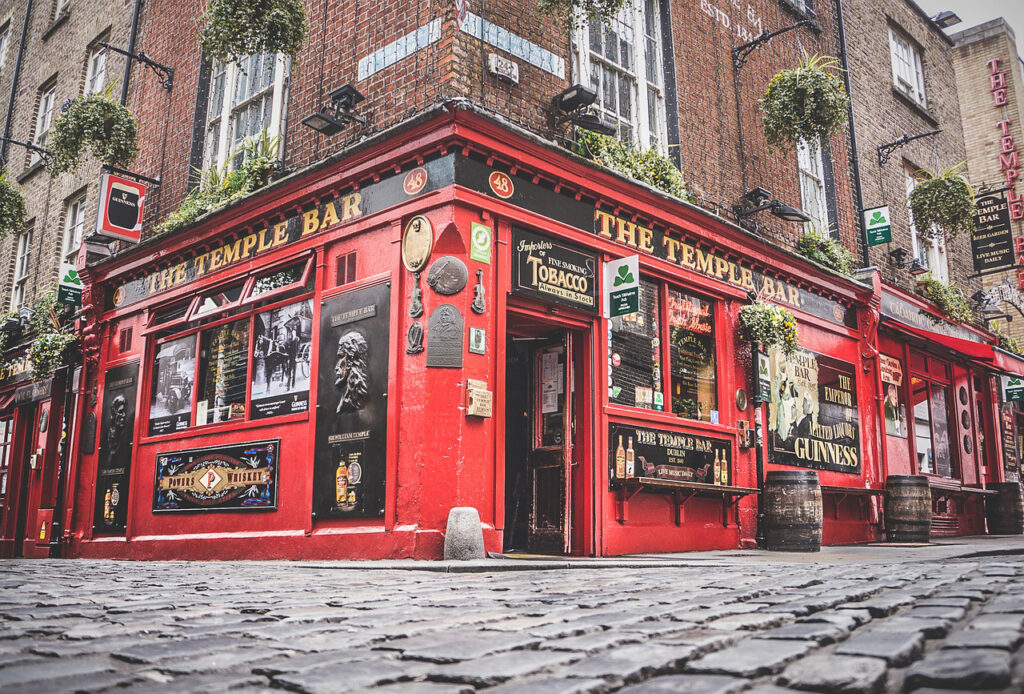
The world-famous Temple Bar in Dublin.
Drinking in Dublin
The start of an epic golf adventure belongs in the Emerald Isle’s crown jewel
One of Europe’s cultural hubs, Dublin is worthy of a trip all its own. In lieu of a longer stay, don’t miss the twin attractions designed to honor Ireland’s unofficial pastime: Drinking.
The Guinness Factory
guinness-storehouse.com
No trip to Dublin would be complete without a pint or two in the Guinness Storehouse and factory tour. Like a beer drinker’s Disney World, the factory takes you behind the scenes of the famous beer’s brewing and history. You’ll even learn the proper way to pour a pint of the brew itself. Cheers!
The Jameson Factory
jamesonswhiskey.com
It’s no surprise that the makers of one of the world’s finest whiskeys would be the winner of the world’s best distillery tour, but the Jameson Whiskey distillery in Dublin earned a top-ranked double, in 2018 and 2019 by the World Travel Awards. Enjoy a wee nip (or two) of the good stuff while learning the company’s rich past and impressive process.
A Plethora of Pubs
As legendary Irish author James Joyce once wrote, “a good puzzle would be to cross Ireland without passing a pub,” and that would be doubly tough in Dublin. Today the city is home to more than 750 establishments of all shapes and sizes. A few favorites include the quintessential Irish pub called the Temple Bar (thetemplebarpub.com), home to 450 (!) different whiskeys, Toners Pub (www.tonerspub.ie), and Dublin’s oldest establishment, the historic Brazen Head (www.brazenheadpub.com), which has been pouring pints since 1198 A.D.!
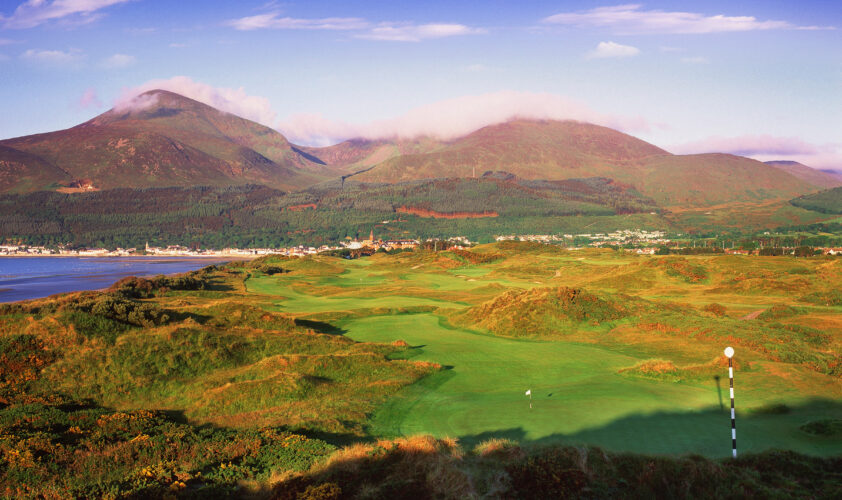
 ';
';
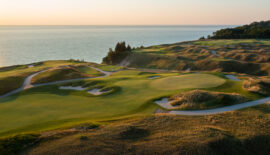 ';
';
 ';
';
 ';
';